Service procedures
Always clean the master cylinder reservoir and
caps before checking fluid level. If not cleaned, dirt
could enter the fluid.
The fluid fill level is indicated on the side of the
master cylinder reservoir (Fig. 9).
The correct fluid level is to the FULL indicator on
the side of the reservoir. If necessary, add fluid to the
proper level.
1 - INDICATOR 2 - RESERVOIR A new master cylinder should be bled before installation
on the vehicle. Required bleeding tools include
bleed tubes and a wood dowel to stroke the pistons.
Bleed tubes can be fabricated from brake line. BLEEDING PROCEDURE (1) Mount master cylinder in vise.
(2) Attach bleed tubes to cylinder outlet ports.
Then position each tube end into the reservoir (Fig.
10).
(3) Fill reservoir with fresh brake fluid. (4) Press cylinder pistons inward with wood dowel.
Then release pistons and allow them to return under
spring pressure. Continue bleeding operations until
air bubbles are no longer visible in fluid.
1 - BLEEDING TUBES 2 - RESERVOIR Use Mopar brake fluid, or an equivalent quality
fluid meeting SAE J1703-F and DOT 3 standards
only. Use fresh, clean fluid from a sealed container at
all times.
Do not pump the brake pedal at any time while
bleeding. Air in the system will be compressed into
small bubbles that are distributed throughout the
hydraulic system. This will make additional bleeding
operations necessary.
Do not allow the master cylinder to run out of fluid
during bleed operations. An empty cylinder will allow
additional air to be drawn into the system. Check the
cylinder fluid level frequently and add fluid as
needed.
Bleed only one brake component at a time in the
following sequence: MANUAL BLEEDING (1) Remove reservoir filler caps and fill reservoir.
(2) If calipers, or wheel cylinders were overhauled,
open all caliper and wheel cylinder bleed screws.
Then close each bleed screw as fluid starts to drip
from it. Top off master cylinder reservoir once more
before proceeding. (3) Attach one end of bleed hose to bleed screw
and insert opposite end in glass container partially
filled with brake fluid (Fig. 11). Be sure end of bleed
hose is immersed in fluid.
1 - BLEED HOSE 2 - FLUID CONTAINER PARTIALLY FILLED WITH FLUID (4) Open up bleeder, then have a helper press
down the brake pedal. Once the pedal is down close
the bleeder. Repeat bleeding until fluid stream is
clear and free of bubbles. Then move to the next
wheel. PRESSURE BLEEDING Follow the manufacturers instructions carefully
when using pressure equipment. Do not exceed the
tank manufacturers pressure recommendations. Generally,
a tank pressure of 15-20 psi is sufficient for
bleeding.
Fill the bleeder tank with recommended fluid and
purge air from the tank lines before bleeding.
Do not pressure bleed without a proper master cylinder
adapter. The wrong adapter can lead to leakage,
or drawing air back into the system. Use
adapter provided with the equipment or Adapter
6921. The disc brake rotor can be machined if scored or
worn. The lathe must machine both sides of the rotor
simultaneously with dual cutter heads. The rotor
mounting surface must be clean before placing on the
lathe. Equipment capable of machining only one side
at a time may produce a tapered rotor. NOTE: A hub mounted on-vehicle lathe is recommended.
This type of lathe trues the rotor to the
vehicles hub/bearing. CAUTION: Brake rotors that do not meet minimum
thickness specifications before or after machining
must be replaced. The brake drums can be machined on a drum lathe
when necessary. Initial machining cuts should be limited
to 0.12 - 0.20 mm (0.005 - 0.008 in.) at a time as
heavier feed rates can produce taper and surface
variation. Final finish cuts of 0.025 to 0.038 mm
(0.001 to 0.0015 in.) are recommended and will generally
provide the best surface finish.
Be sure the drum is securely mounted in the lathe
before machining operations. A damper strap should
always be used around the drum to reduce vibration
and avoid chatter marks.
The maximum allowable diameter of the drum
braking surface is stamped or cast into the drum
outer edge. CAUTION: Replace the drum if machining will
cause the drum to exceed the maximum allowable
diameter. A preformed metal brake tube is recommended and
preferred for all repairs. However, double-wall steel
tube can be used for emergency repair when factory
replacement parts are not readily available.
Special bending tools are needed to avoid kinking
or twisting of metal brake tubes. Special flaring tools
are needed to make a double inverted flare or ISO
flare (Fig. 12). DOUBLE INVERTED FLARING (1) Cut off damaged tube with Tubing Cutter.
(2) Ream cut edges of tubing to ensure proper
flare.
(3) Install replacement tube nut on the tube.
(4) Insert tube in flaring tool.
(5) Place gauge form over the end of the tube.
(6) Push tubing through flaring tool jaws until
tube contacts recessed notch in gauge that matches
tube diameter.
(7) Tighten the tool bar on the tube
(8) Insert plug on gauge in the tube. Then swing
compression disc over gauge and center tapered flaring
screw in recess of compression disc (Fig. 13).
1 - ISO-STYLE FLARE 2 - DOUBLE INVERTED-STYLE FLARE (9) Tighten tool handle until plug gauge is
squarely seated on jaws of flaring tool. This will start
the inverted flare.
(10) Remove the plug gauge and complete the
inverted flare.
ISO FLARING To make a ISO flare use Snap-Ont Flaring Tool
TFM-428 or equivalent.
(1) Cut off damaged tube with Tubing Cutter. (2) Remove any burrs from the inside of the tube.
(3) Install tube nut on the tube.
(4) Position the tube in the flaring tool flush with
the top of the tool bar (Fig. 14). Then tighten the tool
bar on the tube.
(5) Install the correct size adaptor on the flaring
tool yoke screw.
(6) Lubricate the adaptor.
(7) Align the adaptor and yoke screw over the tube
(Fig. 14).
(8) Turn the yoke screw in until the adaptor is
squarely seated on the tool bar.
1 - ADAPTER 2 - LUBRICATE HERE 3 - PILOT 4 - FLUSH WITH BAR 5 - TUBING 6 - BAR ASSEMBLYBrake fluid level
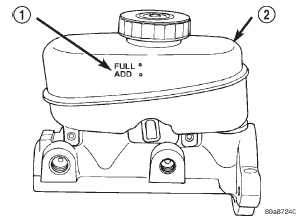 Fig. 9 Master Cylinder Fluid Level - Typical
Fig. 9 Master Cylinder Fluid Level - TypicalMaster cylinder bleeding
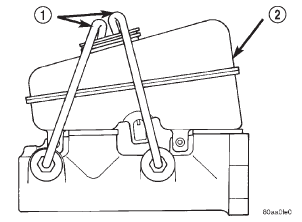 Fig. 10 Master Cylinder Bleeding
Fig. 10 Master Cylinder BleedingBase brake bleeding
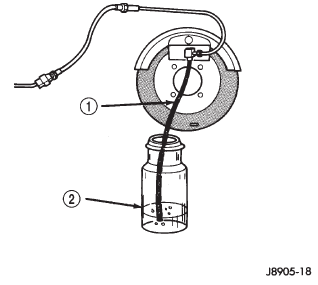 Fig. 11 Bleed Hose Setup
Fig. 11 Bleed Hose SetupDisc rotor machining
Brake drum machining
Brake tube flaring
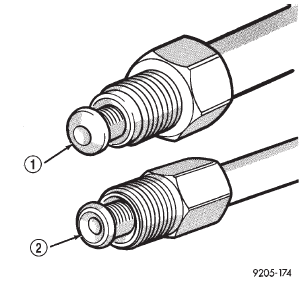 Fig. 12 Inverted Flare And ISO Flare
Fig. 12 Inverted Flare And ISO Flare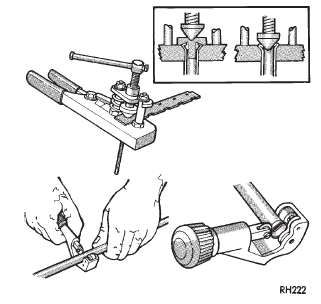 Fig. 13 Inverted Flare Tools
Fig. 13 Inverted Flare Tools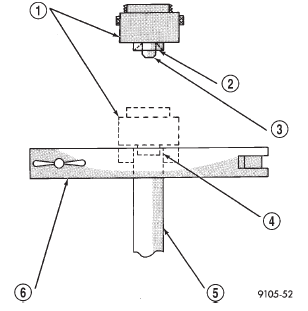 Fig. 14 ISO Flaring
Fig. 14 ISO Flaring
Dodge Durango (DN) 1998-2003 Service Manual
- Lubrication and Maintenance
- Suspension
- Differential and Driveline
- Brakes
- Cooling System
- Battery
- Starting Systems
- Charging System
- Ignition System
- Instrument Panel Systems
- Audio Systems
- Horn Systems
- Speed Control System
- Turn Signal and Hazard Warning Systems
- Wiper and Washer Systems
- Lamps
- Passive Restraint Systems
- Electrically Heated Systems
- Power Distribution System
- Power Lock Systems
- Vehicle Theft/Security Systems
- Power Seat System
- Power Window Systems
- Power Mirror Systems
- Chime/Buzzer Warning Systems
- Overhead Console Systems
- Engine
- Exhaust System
- Frame and Bumpers
- Fuel System
- Steering
- Transmission and Transfer Case
- Tires and Wheels
- Body
- Heating and Air Conditioning
- Emission Control Systems
- Introduction
